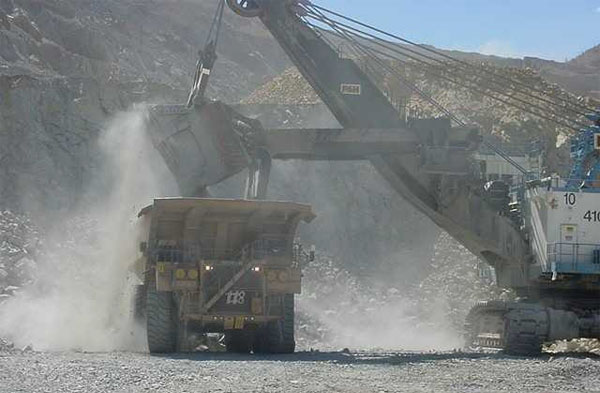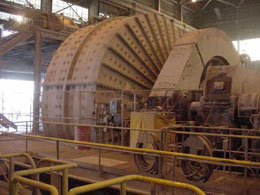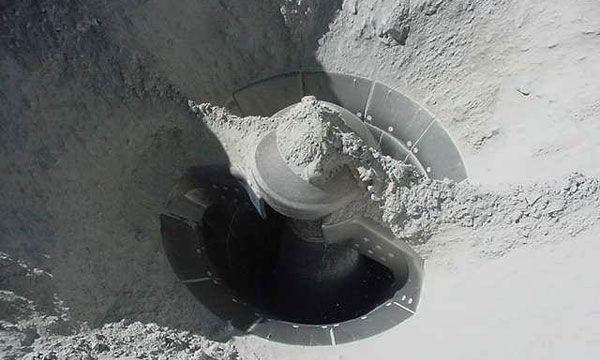Sulfide Ores
Sulfide copper minerals are a combination of substances, including the elements of copper and sulfur.
If enough copper minerals are present in rock to make it economically feasible to mine, process and refine, it is called ORE.
Blasting and Crushing
Ore must be blasted with explosives to break it into manageable sized pieces.
Most of the ore has only 0.d—0.6% copper (8 to 12 pounds of copper) in each ton.
Blast boles are drilled into the rock, explosives arc put in the bottom of the boles and the top part of the boles are filled with gravel so that the energy of the explosion will break up the rock instead of blowing into the air.
Electric powered shovels pick up the fractured ore and load it into a haul truck.
The shovels can load over 100 tons with each scoop. Haul trucks can carry hundreds of tons of ore can “average” pickup truck holds 1/2 ton).
The haul trucks take the ore to a large machine called a crusher where it is reduced to rocks that average eight inches in diameter – about the size of a soccer ball.
In some plants, the ore is then crushed even smaller in secondary crushers.
Milling
From the crusher, belt conveyors carry the ore to huge, horizontal steel cylinders called mills that rotate or spin. The ore is mixed with water as it enters the mills.
As the mill rotates, the ore is crushed into very small sized pieces using either steel balls, long rods or sometimes just the ore and water. The ore is milled until it is so small that, mixed with liquid, it looks like thin, watery mud. This is called slurry.
The slurry contains all of the rock that has been ground up and the small copper particles that have been “liberated,” or broken out of, the rock.
Flotation and Concentrating
The slurry then flows to the next step in the process called flotation.
- Liquids called reagents (substances used in preparing a product for processing because of their chemical or biological properties) are added to the slurry on its way to the floatation area.
- One reagent called a ”collector” is chemically attracted to copper and not attracted to water. It is a type of oil.
- Another reagent called “frother” forms a strong bubble to which the “collector” will eventually cling.
The slurry and added reagents flow into large vats (metal containers) called floatation cells.
- Propeller-like agitators blow air into the bottom of the floatation cells. The agitator keeps the slurry mixed up and breaks the air into little bubbles that travel to the surface.
- The oily “collectors,” with copper attached, stick to the bubbles and are carried to the surface where they attach to the “frother” strengthened bubbles.
- The agitation causes the bubbles to move to the outside edge of the vat where they overflow and 3re carried to large tanks called thickeners.
The copper slurry produced in flotation is called concentrate.
- The copper concentrate sinks to the bottom of the thickeners where it is pumped to filters that vacuum water out if it, preparing it for transport to the next steps in the process, the smelter.
The water that is removed from the thickeners is pumped back into the mill and reused- The result is a mixture of copper and other metals called copper concentrate and it is approximately 30% copper.
Tailings
The slurry that remains after the copper concentrate has been removed is a waste material called tailings.
When you consider that only about 0.6% of the rock that enters the mill is copper that leaves 99.d-% of left over rock.
Tailings slurry flows from floatation to thickeners where excess water is removed.
The tailings are then pumped to a large area called tailings impoundments or tailings dams.
A great deal of effort goes into making sure that the tailings are disposed of in a way that is not harmful to the environment.
Smelting
At the smelter, the copper concentrate goes through four processes:
The smelting furnace -
The concentrate is smelted, instantly converting the ground-up rock into a molten liquid that is 2,300 degrees Fahrenheit and looks like molten lava from a volcano.
This produces a combination of matte (a mixture of copper, sulfur and iron) and slag (a dense, glassy material of mostly iron and silica).
This molten mix is tapped (poured in a controlled way) out of the smelting furnace and enters the slag settling furnace.
Due to different densities, the matte settles down through the slag- Slag is then disposed of on the slag dump.
Matte contains 58-60% copper. The matte is tapped from the slag settling furnace and flows into a ladle that is picked up by an overhead crane and poured into the converter.
The converter -
The matte goes to the converter where most of the remaining iron and sulfur is removed by blowing air into the mixture. The resulting product is blister copper that is more than 98% pure copper.
The convener is then rolled and the molten copper is poured from the converter into a ladle and transported by the overhead crane to the anode furnace.
The anode furnace -
The blister copper is poured into the anode furnace where additional refining is performed to prepare the copper to he poured into anodes.
This refining is completed by adding air and natural gas to the mixture.
The anode casting wheel -
Copper from the anode furnace is then poured into copper molds to produce anodes.
Anodes are slabs of copper that are about 2 inches thick, 3 feet wide and 3 1/2 feet tall. The anodes weigh about 750 lbs. each and are about 99.07o pure copper. They are then shipped to the refinery where they undergo even more refining.
Refining
Even though the anodes from the smelter 3re 99% pure copper, they still contain too many impurities for the strict demands of wire manufacturers.
These impurities have a negative effect on the wire drawing capability of copper. Therefore, the anodes are sent to an electrolytic refinery to remove those impurities.
The term electrolytic means electricity is used along with a solution (or electrolyte) to refine the anodes into a saleable copper product.
At the Refinery—Turning Anodes into Cathodes…
The anodes are suspended in a solution of sulfuric acid and copper sulfate between two starter sheets (thin sheets of copper).
As an electrical current is passed through the tanks, the copper from the anodes is dissolved into the solution and plates onto the starter sheets.
After 1d- days, the starter sheet has accumulated enough copper to be removed from the tank rinsed with water and bundled- It is now called a cathode and is 99.98% pure copper.
The copper cathodes are ready to be sent on to be processed into the copper products we use every day.
The used anodes are melted, re-cast into new, full-sized anodes and returned to the refinery to go through the process again.
During the refining process, some impurities dissolve into the solution and are recovered, such 35 nickel. Other impurities do not dissolve and settle to the bottom of the tank. These impurities are silver, gold, platinum, selenium and tellurium—and they are recovered and sold as by-products.




